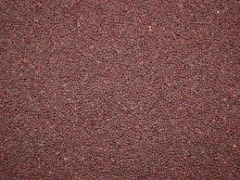Mustard Seed
| Infobox on Mustard Seed | |
|---|---|
| Example of Mustard Seed |  |
| Facts | |
| Origin | See text |
| Stowage factor (in m3/t) | - |
| Angle of repose | - |
| Humidity / moisture | - |
| Oil content | - |
| Ventilation | - |
| Risk factors | See text |
Mustard Seed
Description
Mustard seeds are the small round seeds of various mustard plants. The seeds are usually about 1 or 2 mm in diameter. Mustard seeds may be coloured from yellowish white to black. They are important spices in many regional foods. The seeds can come from three different plants: black mustard (Brassica nigra), brown Indian mustard (Brassica juncea), and white mustard (Brassica hirta/Sinapis alba).
Mustard seeds generally take three to ten days to germinate if placed under the proper conditions, which include a cold atmosphere and relatively moist soil. Mature mustard plants grow into shrubs.
Mustard grows well in temperate regions. Major producers of mustard seeds include Canada, Hungary, Great Britain, India, Pakistan and the United States. Brown and black mustard seeds return higher yields than their yellow counterparts.
Mustard seed is a rich source of oil and protein. The seed has oil as high as 46-48%, whole seed meal has 43.6% protein.
Shipment / Storage / Risk factors
Mustard seed is usually shipped in bags. If packed in a moist state there is a risk of fermentation. Contact with water, whether fresh or salt, results in the immediate deterioration of quality.
Heat, unless excessive, usually has no ill effect on mustard seed. Sale of damaged seeds should be arranged without delay.
See also Oil Seeds.











